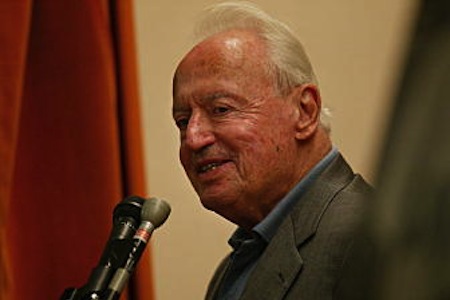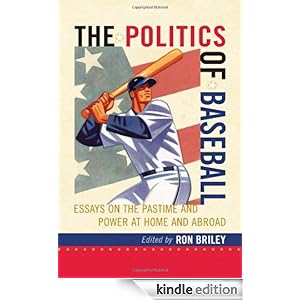When Will Marvin Miller Be Inducted into the Baseball Hall of Fame?

Marvin Miller in 2003. Credit: Wiki Commons.
 In early January, the Baseball Hall of Fame Class of 2013 will be announced. On the ballot for the first time will be controversial stars from the steroids era such as Barry Bonds, Roger Clemens, and Sammy Sosa. Missing from the ballot, however, is Marvin Miller whose candidacy for Cooperstown was rejected five times. On November 27, 2012, Miller died at the age of ninety-five from cancer. He did not live to see his enshrinement into the Hall and even had to suffer the indignity of witnessing the induction of his nemesis, the former commissioner of baseball Bowie Kuhn. On the other hand, Miller, as executive director of the Major League Baseball Players Association (MLBPA), transformed the game of baseball and professional sport in the United States. When Miller assumed his position as executive director in 1966, the minimum player salary was $6,000 and the average salary was $19,000. By the time Miller retired in 1982, the players enjoyed the benefits of a generous pension plan and free agency with an average salary of $241,000.
In early January, the Baseball Hall of Fame Class of 2013 will be announced. On the ballot for the first time will be controversial stars from the steroids era such as Barry Bonds, Roger Clemens, and Sammy Sosa. Missing from the ballot, however, is Marvin Miller whose candidacy for Cooperstown was rejected five times. On November 27, 2012, Miller died at the age of ninety-five from cancer. He did not live to see his enshrinement into the Hall and even had to suffer the indignity of witnessing the induction of his nemesis, the former commissioner of baseball Bowie Kuhn. On the other hand, Miller, as executive director of the Major League Baseball Players Association (MLBPA), transformed the game of baseball and professional sport in the United States. When Miller assumed his position as executive director in 1966, the minimum player salary was $6,000 and the average salary was $19,000. By the time Miller retired in 1982, the players enjoyed the benefits of a generous pension plan and free agency with an average salary of $241,000.
Miller was convinced that baseball owners exerted a degree of revenge by denying him membership in the Hall of Fame. He concluded, however, that while they might be able to exclude him from Cooperstown, they could not ignore the history of the MLBPA, which became one of the most powerful unions in the land during an era when labor was on the defensive and “stagflation” was threatening worker wages, benefits, and savings during the 1970s. Speaking of his last snub by voters of the executives and pioneers committee in 2010, Miller commented, “You can leave individuals out, but you can’t leave out an organization. You can’t leave out the impact the union has had. You can’t be anything but fraudulent if you pretend that you are the archivist and recorder of the history of an institution like Major League Baseball and leave the union out of it. I have more fame than I would have had in the Hall of Fame.”
And Miller was always more of a union man than a baseball fan. He was born on April 14, 1917 in the Bronx and grew up in Brooklyn. His father was a salesman for a Manhattan clothing company, and his mother was an elementary school teacher and a proud member of the New York City teachers union. Miller graduated from New York University in 1938 with a degree in economics. During the Second World War, Miller worked for the National War Labor Board to resolve labor-management disputes. Following the war, Miller found employment in the labor movement with the International Association of Machinists and the United Auto Workers. In 1950, he joined the staff of the United Steelworkers Union, becoming an assistant to the union president and taking a leading role in contract negotiations.
In 1966 the MLBPA was essentially a company union when players Jim Bunning, Robin Roberts, and Harvey Kuenn approached Miller about assuming the leadership of their fledgling organization. Miller was intrigued but reluctant to assume the baseball post, and many players were hesitant about being associated with the union movement. Accordingly, Miller visited training camps in the spring of 1966 and was successful in winning a majority of the players over to his side. Miller acknowledged that his biggest challenge was to make the individualistic baseball players think like steelworkers. The baseball paternalism confronting Miller was exemplified in the sport’s reserve clause which bound players in perpetuity to the clubs that signed them; negating free agency and keeping salaries low. In addition, player grievances could only be heard by the commissioner, who was selected by team owners.
While new revenues were available for the sport due to baseball’s expansion to the West Coast and South, the overall climate for American labor was not promising. Thus, Miller and his union engaged in a series of labor stoppages in the 1970s when the labor movement was in decline. In 1972, the MLBPA staged the first major strike in the history of professional sports in the United States, leading to cancellation of games for the first nine days of the season and gaining increased contributions to the players’ pension fund. In 1968, Miller and the MLBPA completed the first collective bargaining agreement in professional sports, and two years later the players gained the right to have their grievances heard before an impartial arbitrator. Later in 1970, St. Louis Cardinals outfielder Curt Flood decided to challenge the reserve clause after he was traded to the Philadelphia Phillies. Miller and the MLBPA agreed to support Flood’s legal case which reached the Supreme Court. While the Court failed to uphold Flood’s challenge, the reserve cause was overturned in a December 1975 decision by arbitrator Peter Seitz in a case brought by pitchers Andy Messersmith and Dave McNally and supported by the union. When the owners proved unable to overturn Seitz’s ruling after locking the players out of spring training in 1976, Miller negotiated an agreement which limited free agency to players with six years of service at the Major League level. Miller astutely recognized that placing some limitations on free agency would allow for a more competitive market with free agent players. For example, in 1976 the average annual player salary was $51,000, and at the end of the year free agent Reggie Jackson signed a five-year, $29 million contract. When the owners sought to curtail free agency by demanding greater compensation for teams losing a player, the MLBPA engaged in a fifty-day strike during the 1981 season. Meanwhile, the pension fund from national television rights was bringing in $15.5 million a year in a four-year agreement reached in May 1980.
When Miller retired as executive director in 1982, baseball at the Major League level was forever changed. The reserve clause was gone and replaced by arbitration and free agency which pushed salaries upward and allowed athletes to address their complaints with management. Another legacy of Miller’s tenure was an antagonistic relationship between the union and ownership which culminated in a 1994 strike that canceled the World Series. Since that pivotal labor stoppage, collective bargaining agreements have been achieved without a strike, but the sport has been plagued with the issue of steroid usage. Ownership seems to have finally accepted the changes in their prerogatives wrought by Marvin Miller, the union man who brought the negotiating tactics of the steelworkers to the green pastures of the baseball field. Despite this labor calm and a game today which is more competitive than ever, even with the high salaries of free agency, Miller believed that the owners enacted their measure of revenge by denying him membership in the Hall of Fame, while enshrining controversial champions of management such as Kuhn and Walter O’Malley, who moved the Dodgers from Brooklyn to Los Angeles. Marvin Miller’s name will not be announced when the baseball writers vote for the 2013 Cooperstown inductees. Nevertheless, it is high time that Miller’s contributions to baseball be recognized by a plaque in Cooperstown. Unfortunately, as with Ron Santo and Buck O’Neil, this honor will be bestowed posthumously. Too bad, as it would have been interesting to hear Miller take on the baseball establishment for one last time.
